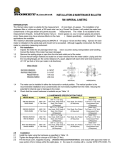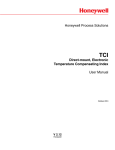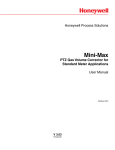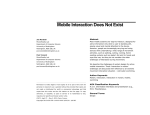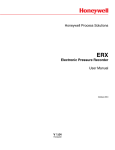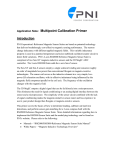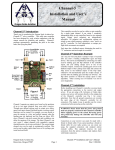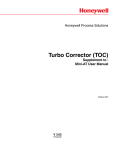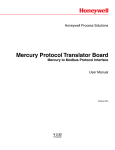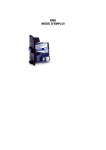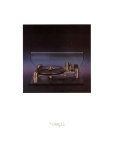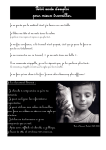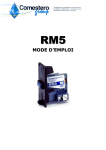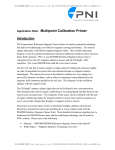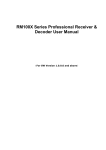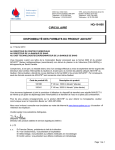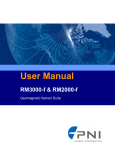Download Mini-Max Rotary Corrector - User Manual
Transcript
Honeywell Process Solutions Mini-Max Rotary Corrector Direct-mount, PTZ Volume Corrector for Rotary Meters Supplement to Mini-Max User Manual October 2010 V 1.03 Honeywell 2 www.honeywell.com Rotary Corrector TABLE OF CONTENTS 4 Introduction .....................................................................................................................................................5 5 Installation Instructions .....................................................................................................................................6 9 Setting the instrument Parameters ...................................................................................................................10 11 Instrument Mounting Plate Identification .........................................................................................................12 13 Input Sensor ..................................................................................................................................................14 13 Redundant Electronic Index ...........................................................................................................................14 13 REI Alarms .......................................................................................................................................14 14 Live Dial Rate Display ...................................................................................................................................15 15 Differential Performance Test .........................................................................................................................16 16 Item List ........................................................................................................................................................17 17 Meter Proving ................................................................................................................................................18 Rotary Corrector 1.00 1.01 1.03 Initial Release Revision Revision List Cover page May 2003 June 2008 Honeywell update October 2010 3 Rotary Corrector Introduction The Mini-Max Rotary Corrector is a full featured Mini Max (or Mini-Max AT) electronic gas volume corrector specially adapted to direct mount to various rotary meters. The Rotary Corrector uses a sensor to collect input volume pulses from the sensor well of the rotary meter. The Rotary Corrector functions in much the same manner as the standard Mini-Max or Mini-Max AT. A PC (desktop or laptop computer) is needed to configure and download the Rotary Corrector using MasterLink32 software. Detailed information regarding the software is available through the MasterLink32 help screens. In addition to its small, sturdy case, the Rotary Corrector offers these and other features: • Integral design, i.e. Instrument drive not required • High-performance, low power microprocessor • Extended battery life • Audit Trail memory capacity (40 days of daily or hourly) • FLASH memory (hence, no plug-in EPROMs) • Field programmable firmware updates • Two Form-A outputs for Volume and one Form-A output for Alarms • Software selectable Pulse Widths for volume pulses • Serial port (CMOS) with automatic baud rate settings (optional RS-232 port) • High-speed data transfers (up to 38.4 kbaud) • On-board surge protection for serial & pulse data • Field replaceable Alkaline batteries • Electronic uncorrected volume backup Note: This manual is intended for use as a supplement to the Mini-Max Operator’s Guide and should be used in conjunction with that manual. 4 www.honeywell.com Rotary Corrector INSTALLATION INSTRUCTIONS OF THE MINI-MAX ROTARY CORRECTOR (Dresser & Romet) 1. Remove the contents from the box and from the mounting kit bag. 2. Review the contents and identify each item per the parts list included. 3. Select the adapter mounting plate, four 10-32 x 2”SS flat head screws (60-1374), and four countersink star washers (20-9505). Meter Adapter Plate Flathead Screws (60-1374) Star Washers (20-9505) Sensor Hub 4. Identify the proper orientation of the adapter mounting plate in relationship to the meter. Ensure the correct mounting plate is being used for the specific kind of meter by referencing the stamping on the plate. Ensure the threaded sensor hub is facing inside the Mini-Max enclosure. 5. Without putting undue stress on the sensor connector, thread the sensor into the mounting plate. This can be accomplished by rotating the plate while holding the sensor, or rotating the sensor after removing it from the clips and connector. 6. Place the spiral nylon insulator, pointed end first, in the temperature probe chamber of the meter and cut to the required length. This will help center the probe and reduce the potential risk of stray electrical current coming in contact with the probe. 5 Rotary Corrector 7. Place the countersink star washers on the four 10-32 x 2” screws and mount the adapter plate to the Mini-Max using the four screws. To assure a reliable seal to the adapter plate, push the O-ring located around the case side port against the adapter plate. At this point the Mini-Max should be configured to mount onto the meter end. Push O-ring against adapter plate Temperature Probe Sensor 8. Identify the meter gasket, meter mounting screws and lockwashers. Mounting Screws Meter Gasket 6 www.honeywell.com Rotary Corrector 9. Place the meter gasket against the meter end, and attach the Mini-Max with adapter plate to the meter using the meter mounting screws and lockwashers. Four lockwashers are provided in the kit and they can be placed onto any of the mounting screws. Be aware that there is one meter mounting screw internal to the Mini-Max for LMMA (including 7M-16M) installations. 10. If provided, insert the temperature probe through the appropriate fitting on the adapter mounting plate from within the Mini-Max. Position the probe to the desired location and secure by tightening the nut using a 7/16” open-end wrench. Temperature Probe Fitting 11. If provided, connect the pressure tubing to the Mini-Max and then to the external pressure tap on the meter 12. . Place the battery pack against the side port facing the meter, then secure with the Velcro strap. Ensure the sensor ribbon cable is folded and condensed as much as possible. Velcro Strap Battery Pack 7 Page 8 Rotary Corrector 13. Ensure the open end of the air vents are rotated toward the ground so to protect from entrance of moisture. Tighten the inside nut to secure the vent in place. 14. Connect the battery cable to J3 or J4 on the main board to start up the unit. 15. Link to the instrument and select item 432. Choose the appropriate meter model. 16. Select item 433 and choose “Enabled”. The sensor will now begin to read andupdate meter volume. Choose “Prover” when proving the instrument. 17. If desired, place item 434 in the meter reader list. 18. Synchronize item 002 with item 434 to have a coordinated totalized uncor volume. Do this by writing a value to item 002 that matches the reading at item 434. (Note: If all is operating correctly, item 002 and 434 should read the same value.) 19. Disconnect or unlink from the instrument. 20. Check the operation of the LCD by scrolling through the display list using the MI pushbutton. 21. Secure the front door by tightening the four Phillips head screws evenly. Ensure the door is configured so the MI logo and the LCD are right side up. (The door is symmetrical and can be rotated to accommodate different meter positions) Door Screws MI Logo Pushbutton Air Vents 8 www.honeywell.com Page 9 Rotary Corrector Setting up the instrument Parameters There are two item settings that must be made for the Rotary Corrector to function properly. The first is the Meter Index Rate (Item 098) and the second is the Meter Scaling Factor (Item 114). The values at items 098 and 114 are automatically set by the firmware simply by selecting the Meter type and size at item 432. The following two tables show the correct setting for the different meter sizes and manufacturers. For manually setting the parameters, find the table with the correct meter manufacturer, go down the size column to the proper size. Go across the row to the column that contains the appropriate setting of Item 114 in relation to Item 098. Dresser LMMA Meters Item 098=2 Item 098=3 (10 CuFt) (100 CuFt) Set Item 114 Set Item 114 to: to: Meter Size 1.5M 0.1896107 0.0189611 3M 0.3792213 0.0379221 5M 0.6321493 0.0632149 7M 1.0666667 0.1066667 11M 1.7066667 0.1706667 16M 2.5284267 0.2528427 23M 4.4791467 0.4479147 38M 8.7722667 0.8772267 56M 15.0818133 1.5081813 102M 35.7785600 3.5778560 Table 1 Dresser LMMA Meter Values 9 Rotary Corrector Meter Size RM1000 RM1500 RM2000 RM3000 RM5000 RM7000 RM11000 RM16000 Romet Meters Item 098=2 Item 098=3 (10 CuFt) (100 CuFt) Set Item 114 Set Item 114 to: to: 0.1369532 0.0136953 0.1896294 0.0189629 0.2614579 0.0261458 0.3792589 0.0379259 0.6269372 0.0626937 1.0448964 0.1044896 1.6960649 0.1696065 2.4032649 0.2403265 Table 2 Romet Meter Values 10 www.honeywell.com Rotary Corrector Rotary Meter Mounting Plate Identification The following pages serve as a reference to identify which instrument mounting plate adapts to which meter. Be sure to take into account the meter manufacturer, meter series, meter size, and temperature probe location when ordering or installing the appropriate mounting kit. Dresser LMMA 1.5-5M, 23M-102M Kit #20-9424 Dresser LMMA 7M-16M Kit #20-9425 11 Rotary Corrector Romet 1000-5000 Internal Temperature Probe Kit #20-9426 Romet 7000-16000 Internal Temperature Probe Kit #20-9427 Romet External Temperature Probe Kit #20-9477 12 www.honeywell.com Page 13 Rotary Corrector Input Sensor The Rotary Corrector receives volume pulses directly from an input sensor mounted in the body of the meter. The sensor threads into the rotary meter mounting plate and connects to the Mini-Max main board at J2 via a ribbon cable. The connector is keyed, thus preventing the possibility of incorrect connections. Ribbon Cable Sensor Body Sensor Connection to main board Note: There are two types of sensors. The original Rotary corrector units had the standard sensor (p/n: 40-2910). Newer units will have the REI sensor (p/n 40-2983) with additional functionality discussed below. The two sensor units are physically interchangeable but the REI requires an updated firmware version (2.40 or higher) to support its added features. Redundant Electronic Index (REI) The REI sensor has the ability to store input pulses from the meter. The Mini-Max reads the value from the REI and converts it to an uncorrected volume reading, scaled to the units selected at item 092. To activate this feature, item 433 must be set to Enabled. The converted value is stored at item 434. Since Item 434 is a backup reading it is only updated on a serial link, meter read or start of gas day. It is not updated on hourly Audit Trail logs or volume pulse inputs. In normal operation, the value of item 434 should match, or be very close to, the value of item 002. REI Alarms A set of alarms are associated with the REI sensor. The alarm status is stored in Item 435. A value of zero (0) indicates that there is no alarm currently active in the REI. A value other than zero indicates that an alarm has occurred in the REI. MasterLink32 will automatically intepret the value and display the alarm description. See the table below for a description of alarm codes. Value 0 1 2 3 4 5 6 7 Alarm None Battery Low Read Error Battery Low & Read Error Write Error Battery Low & Write Error Read Error & Write Error Battery Low, Read Error & Write Error Cause Low Battery in the REI Mini-Max is unable to read from the REI Mini-Max is unable to write to the REI 13 Rotary Corrector Live Dial Rate Display The Rotary Corrector has the ability to display live dial rate on the LCD. This feature is enabled at Item 129. The dial rate is displayed in units of cubic foor per hour (or cubic meters per hour) and has a resolution of one tenth of a cubic foot (or one thousanth of a cubic meter). When enabled, the live dial rate can be displayed by scrolling through the meter read list until the following screen appears. This screen will remain for approximately three seconds before changing to the wait screen below. The wait screen will remain anywhere from one to twenty seconds, depending on the amount of time it takes for the Mini-Max to receive two meter volume pulses through the sensor. After receiving the two volume pulses, the Mini-Max will calculate the flow rate and display it on the LCD. If no volume pulses are counted in twenty seconds (approximately 1% of meter capacity), the flow rate displayed will be zero as shown below. After 10 minutes, the display will flash TIMEOUT and return to the corrector mode. 14 www.honeywell.com Page 15 Rotary Corrector Differential Performance Test The condition of a rotary meter can be measured by performing a simple test called the Differential Performance Test. This test requires that the differential pressure across the meter be measured, as well as calculating the dial rate. Normally, calculating the dial rate can be tedious. However, with the Rotary Corrector installed, the dial rate can be displayed via the Live Dial Rate Display. The measured values of the dial rate and differential pressure can then be compared to intial factory data to determine if the meter is performing within specifications. For more information, consult the meter manufacturer’s documentation. 15 Rotary Corrector 16 Item No. 432 Item Name Rotary Meter Model Description Model of the rotary meter the instrument is mounted to. This item will automatically set Items 098 and 114 to their appropriate values. Default=0 Select: 0=Not Applicable 10=Dresser 102M 1=Dresser 1.5M 11=Romet RM1000 2=Dresser 3M 12=Romet RM1500 3=Dresser 5M 13=Romet RM2000 4=Dresser 7M 14=Romet RM3000 5=Dresser 11M 15=Romet RM5000 6=Dresser 16M 16=Romet RM7000 7=Dresser 23M 17=Romet RM11000 8=Dresser 38M 18=Romet RM16000 9=Dresser 56M 433 REI Mode Item used to select the type and operation of the redundant uncorrected volume index. Select: 0=Disabled Default 1=Enabled Standard Configuration 2=Prover 434 REI Uncorrected Volume Backup Total accumulated uncorrected volume from the Redundant Electronic Index. Item 434 is expressed in the units selected at item 092 (Unc Vol Units). When the unit is operating properly, the value at Item 434 should match the value at item 002 (Uncorrected Volume). 435 REI Alarm Item used to indicate whether an alarm has occured in relation to the Redundant Electronic Index. The Alarm conditions are: Electronic Index Battery Low, Electronic Index Read Error and Electronic Index Write Error. Each alarm condition has a specific value associated with it so if multiple alarms have occured, Item 435 will appear as a sum of the alarm values. Alarm Values: 0-No Error 1-Electronic Index Battery Low 2-Electronic Index Read Error 4-Electronic Index Write Error 436 REI Alarm Time The time when the REI Alarm first occurred (Item 435) Default=00:00:00 (Format: HH:MM:SS) 437 REI Alarm Date The date when the REI Alarm first occurred(Item 435) Default: 01-01-02 www.honeywell.com Rotary Corrector ROTARY MINI-MAX PROVING PROCEDURE (DOS Prover Software only) Purpose of the Test: This procedure describes the testing of Rotary Mini-Max accuracy of measuring gas flow through a Roots or Romet rotary meter. Rationale For This Procedure: Using this approach, reasonable test times are achieved, and prover accuracy is maximized. To accomplish this task, a special proving adapter must be used to connect the sensor to the Mini-Max. The pulses/test and test volume values (high, medium, and low flow rates) are specified in Tables 1 & 2 of this procedure. These two values need to be entered into the prover program. The Mini-Max will send output pulses to the prover’s OPTO interface to start and stop the prover. In addition, this procedure is the first version that significantly reduces the complication of meter scaling factors for the user. When the meter model is selected, the factor is loaded into item 114 automatically for normal rotary corrector operation. When prover mode is selected, a divide by 32 is removed internally to allow the corrector to receive pulses faster. Also, “PROVING” is put up on the LCD screen. When the unit is later taken out of prover mode, the LCD returns to normal displaying and internal scaling factors are returned to those that are selected by the meter model. Equipment, Documentation, & Software Needed: This procedure, Mercury Document, “Procedure, Rotary Mini-Max Proving”, FD-489 Model 5 Roots Prover (or equivalent) Rotary Mini-Max Laptop Computer Prover Software (DOS version for the Model 5 Prover) Mercury Master-Link Software Mercury: Cable Assembly, Rotary Mini-Max Prover, 40-2974 Mercury: Assembly, Sensor Proving Adapter, 40-2977 Note: The last 2 items on this list may be acquired by purchasing the Rotary Mini-Max Proving Kit, 209459. Equipment Connections: 1. Mount the meter to be tested on the test stand. 2. Screw the Sensor Probe into the rotary mounting plate, inside the Mini-Max. You may need to remove the battery pack to do this. Route the sensor cable under the battery pack and under the hold-down clip. 3. Mount the Rotary Mini-Max to the meter, using the bolts that are provided in the installation kit. If this is a new instrument and the meter is being set up for field installation, follow the installation instructions, FD-487. Note: Item values specified in FD-487 do not have to be entered at this time, since they will be changed in this procedure. 4. If the Mini-Max is not providing temperature correction, skip to the next step. Install the Mini-Max temperature probe into the meter’s thermowell. 5. Remove the connector end of the Rotary Sensor Probe from the main board. Plug the Sensor Proving Adapter (male end), assembly 40-2977, into the sensor cable (it is keyed). 6. Plug the Sensor Proving Adapter (female end), assembly 40-2977, into the main board, using the diagram below: (J2 viewed above the Mini-Max main board) 17 Rotary Corrector Figure 1: • • • • • • • • • • • • • Line up missing pin with connector plug. 2x5 connector 7. Remove the black connector that is on TB1 (the Mini-Max output pulse connector) and plug in the same type of connector that is part of the Rotary Mini-Max Prover Cable Assembly, #40-2974. If a TC proof is being performed, move the wire that is on YA to YB , on TB1. Note: The color of the wires that connect to this black TB1 connector are “black on YA (YB if using TC)“ and “red on K”. Note: If there is further question about the TB1 wiring, get a DVM (Digital Volt Meter) and set it on the “10 volts DC” setting. Put the red probe on YA (YB if using TC) and the black probe on K. If the DVM reads -0.6 volts instead of 13 volts, then the wires must be reversed. 8. Connect the opposite end of the prover cable to the small blue prover box, on the port labeled “I.D. Pulser”. 9. Connect all of the prover temperature and pressure sensor/cables on the prover. 10. Connect the prover main airflow hose to the test stand and prover master meter. Observe all safety precautions listed in the prover operation manual, especially keeping hands clear of the meter inlet port. 11. Connect the laptop to the Mini-Max, using the communications cable. 12. Connect the prover’s little blue box to its computer box. Software Installations Needed: (go to Mini-Max Item Setup if software is already installed) 13. Install the Prover Software on the laptop computer. 14. Install MasterLink32 Software on the laptop computer. Mini-Max Item Setup (Important Step!): 15. If the Mini-Max items have been previously set up, or have been set up according to special factory specifications, upload the items and save them in an item file, using MasterLink32. 16. To get the Mini-Max configured for prover testing, these items values must be entered (or verified), using MasterLink32: (Find Table 3 at the end of this procedure) Item Description Value or Setting 432 Rotary Meter Model Select Meter Model being tested 433 Index Mode Prover 56 Pulser A Scaling 2.0 93 Pulser A Vol Code UncVol 124 Revs Per Wakeup 1 98 Meter Index Code Select From Table 3 92 Uncorr Volume Units Use the same value as item 98 0 Corrected Volume 00000000 2 Uncorrected Volume 00000000 18 www.honeywell.com Page 19 Rotary Corrector 17. If the Mini-Max is not providing temperature correction, skip to the next step. When using temperature correction, the following additional items must be entered (or verified): 109 Fixed Pressure Factor Fixed 110 Fixed Super Factor Fixed 111 Fixed Factor Temp Live 57 Pulser B Scaling 2.0 94 Pulser B Vol Code CorVol 90 Corr Volume Units Use same value as Item 98 18. Disconnect link with Mini-Max. Prover Setup on the Laptop: 19. Remove the RS-232 communications cable from the laptop. Connect the prover’s communications cable to the laptop. 20. In the prover setup screen, choose the following: Prover Capacity: Select the master meter that has the appropriate flow capacity. Test Control Mode: Set to “OPTO” Meter Output: Set to “UC” for uncorrected volume (Set to “TC” if using temperature correction.) 21. For the next few steps, when the prover software program asks for entry of pulses/test and test volume, a list of values is provided. If the value that you desire is not in the list, select “Enter” from the list; then select the value desired. 22. Select the pulses/test from Table 3*, for the high flow capacity (100%), from column 2. 23. Select the test volume from that same table, for the high flow capacity (100%), from column 3. 24. Enter the 3 flow rates, for high, medium, and low flows, in the prover program. 25. Enter the pulses/test and test volume from that same table, for the medium flow capacity (50%), from columns 4 and 5. 26. Enter the pulses/test and test volume from that same table, for the low flow capacity (10%), from columns 6 and 7. *Note: For a faster (but less accurate) proving operation, use the normal open flow and check flow specifications recommended by the prover manufacturer. For guaranteed accuracy, use the values in table 3. Run the Test: 27. Proceed through the rest of the prover responses that are required and start the test, which should now run the high, medium, and low flow prover tests. Restore Mini-Max: 28. Remove the Sensor Proving Adapter. 29. Plug the sensor cable back into the black connector that is on TB1 main board (figure 1). 30. Upload the item file to the Mini-Max that was saved before the Mini-Max items were modified for the prover needs. This will restore the Mini-Max to the configuration that it was in, prior to prover testing. 31. If desired, adjust the Mini-Max uncorrected and corrected volumes for gas that was bypassed during the proving test. 32. If possible, it is best practice to observe that the Mini-Max is operating properly before leaving the site. This can be done by checking all of the item codes and comparing them to a standard item report printout for the site or by simply watching the CORVOL display registering volume (if meter not too slow). Chose the best technique for your application. Page 20 19 Rotary Corrector 33. Caution: If this is a new Mini-Max installation, be careful to complete the installation procedure, FD487, at this time, especially the item values (which may have been skipped earlier in this procedure). Especially important are items 92, 98 (and other application specific items) that were changed during the prover testing. 34. Caution: Be sure to set Index Mode (Item 433) from “Prover” to “Enabled”. This will restore the unit to proper corrector mode and remove “Proving” from the LCD display. Wrap-Up: 35. The prover test is now complete. The Rotary Mini-Max is ready to be used. 20 www.honeywell.com Rotary Corrector Meter Size 1.5M 2M 3M 5M 7M 11M 16M 23M 38M 56M 102M RM1000 RM1500 RM2000 RM3000 RM5000 RM7000 RM11000 RM16000 Rotary Meter Prover Configuration Drive Pulses Test Pulses Test Pulses Test Rate Per Test Volume Per Test Volume Per Test Volume Meter High High Medium Medium Low Low Index Flow Flow Flow Flow Flow Flow Code Capacity Capacity Capacity Capacity Capacity Capacity (Item 98) (100%) (100%) (50%) (50%) (10%) (10%) (CF) (CF) (CF) (CF) (CF) (CF) (CF) Roots Meters 10 5 50 4 40 3 30 10 5 50 4 40 3 30 10 10 100 9 90 6 60 10 16 160 13 130 10 100 10 23 230 20 200 17 170 10 35 350 30 300 26 260 100 6 600 5 500 5 500 100 8 800 7 700 7 700 100 14 1400 14 1400 14 1400 100 23 2300 23 2300 23 2300 100 55 5500 55 5500 55 5500 Romet Meters 10 3 30 3 30 2 20 10 5 50 4 40 3 30 10 6 60 5 50 4 40 10 8 80 7 70 6 60 10 15 150 12 120 10 100 10 20 200 18 180 16 160 10 34 340 30 300 26 260 10 47 470 43 430 38 380 Table 3 Meter Proving Values 21 Find Out More: To learn more about Mercury Instruments products, contact your Honeywell Process Solutions representative, visit www.mercuryinstruments.com or call 513-272-1111. Automation and Control Solutions Honeywell Process Solutions 3940 Virginia Ave. Cincinnati, OH 45227 513-272-1111 www.honeywell.com MNL-MRC-1 October 2010 © 2010 Honeywell






















